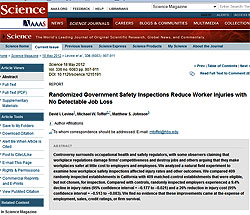Now An American Study Shows Grayling’s Accusation That H&S Is A Business Burden Is Garbage
Tory hatred of Trade Unions, Health & Safety protection at work and employment rights informs their policies, as opposed to facts and realities.
Shortly after Prof Loefstedt’s review findings that health and safety legislation in the UK was broadly correct and not a burden on business, a new study conducted in the USA, whose employment and H&S practices Grayling and co wish to emulate; proves yet again that H&S and in particular unannounced inspections by health and safety regulators can not only improve injury rates in the organisations visited but also has no adverse effect on company profits and employment levels.
 The ten year (1996-2006) US study published in the journal Science last week, challenges the notion that health and safety is bad for business. Indeed the study report title says it all - Randomised Government Safety Inspections Reduce Worker Injuries with No Detectable Job Loss
The ten year (1996-2006) US study published in the journal Science last week, challenges the notion that health and safety is bad for business. Indeed the study report title says it all - Randomised Government Safety Inspections Reduce Worker Injuries with No Detectable Job Loss
The researchers spent ten years comparing more than 800 work sites in California, half of which were subject to random inspections from the Occupational Safety and Health Administration (the US equivalent to the HSE), and half of which were not chosen for inspection.
The abstract of the study published on the Science website states:
“Controversy surrounds occupational health and safety regulators, with some observers claiming that workplace regulations damage firms’ competitiveness and destroy jobs and others arguing that they make workplaces safer at little cost to employers and employees.
We analyzed a natural field experiment to examine how workplace safety inspections affected injury rates and other outcomes.
We compared 409 randomly inspected establishments in California with 409 matched-control establishments that were eligible, but not chosen, for inspection.
Compared with controls, randomly inspected employers experienced a 9.4% decline in injury rates (95% confidence interval = –0.177 to –0.021) and a 26% reduction in injury cost (95% confidence interval = –0.513 to –0.083).
We find no evidence that these improvements came at the expense of employment, sales, credit ratings, or firm survival.”
Safety and Health Practitioner website reports that Michael Toffel, a professor at Harvard Business School and one of the three authors of the study, told Business Week magazine that if OSHA inspections conducted in all 50 US states had the same value as those studied in California, inspected businesses would reap around $6 billion (£3.8 bn) in added value – not including other savings made by avoiding lost production through sick or injured employees.
Toffel said his interviews showed that injuries decrease after inspections because the inspectors talk to operators and make sure they understand what the problems are and then discuss ideas for fixing them. He said:
“It focuses the minds of managers to create solutions, like installing blade guards around a saw, or railings on elevated walkways.”
The SHP article continues:
Peg Seminario, safety and health director at the American Federation of Labor-Congress of Industrial Organizations (AFL-CIO) said:
“[The study] tells us that protecting your workers on the job and keeping them safe is good for workers but also good for business. What's too costly is not addressing injuries and illnesses. We can't afford not to protect people.”
In the US, Dr. David Michaels head of Occupational Safety and Health Administration (OSHA) writing in a blog on the American Dept of Labor website following publication of the study said of his organisation:
“OSHA doesn’t kill jobs; it helps prevent jobs from killing workers.”
 He continues:
He continues:
“I have been promoting that message since I became head of the Occupational Safety and Health Administration almost three years ago. It is supported by empirical evidence—and now—it’s been confirmed by a peer-reviewed study published in Science, one of the world’s top scientific journals.
Not only that, the new study, conducted by professors at the University of California and Harvard Business School, shows that OSHA inspections save billions of dollars for employers through reduced workers compensation costs.”
Commenting on the findings of the study he said:
“……. injury claims dropped 9.4% at randomly chosen businesses in the four years following an inspection by the California OSHA program, compared with employers not inspected.
Those same employers also saved an average of 26% on workers’ compensation costs, when compared with similar firms that were not inspected.
This means that the average employer saved $355,000 (in 2011 dollars) as a result of an OSHA inspection. The effects were seen among small and large employers.”
Commenting further on the study results, Dr David Michaels said:
“Translated to the nation as a whole, OSHA inspections prevent thousands of workplace injuries, while saving employers money and protecting jobs.
The benefits of a randomized safety inspection appear to be substantial. These results do not support the hypothesis that OSHA regulations and inspections on average have little value in improving health and safety.”
His blog concludes:
“The fact is OSHA inspections save lives and jobs at the same time. This is not a surprise to me. I regularly hear from employers, both large and small, that they value OSHA inspections and treat the inspector as an additional, expert set of eyes.
The findings should finally put an end to the criticisms that OSHA inspections make running a business more expensive without adding value. The results are in: OSHA saves lives and jobs!”
Finally some of the statistics regarding cost of work related injuries and illnesses according to SHP are:
In the US in 2010, 3.8 million occupational injuries and illnesses were reported, costing the economy an estimated $250bn-$300bn (£158bn-£190bn). In the same year, 4690 US workers died. The AFL-CIO says OSHA is seriously under-resourced, with just one inspector for every 58,945 workers.
The maximum penalty OSHA can impose for serious violations is $7000 (£4425), and for wilful violations, $70,000 (£44,250). However, in 2011, the average penalty was just $2107 (£1332).
Here in the UK, Grayling's answer to the problem is to make it more difficult for those injured at work to get compensation, and to dramatically reduce the compensation that may be awarded, rather than increase the budget of the HSE, and penalise bad employers who injure and kill their workers in the appropriate manner.
You can download the full study report (at a cost) here
Source: OSHA / Science / SHP / US Dept of Labor



 He continues:
He continues: